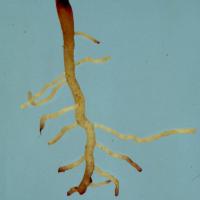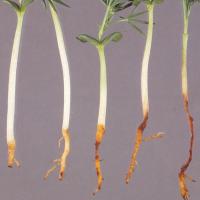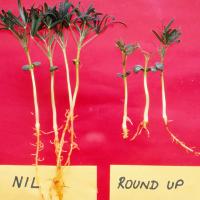Diagnosing rhizoctonia ZG6 in narrow-leafed lupins
Strains of the soil-borne fungus Rhizoctonia solani that causes both hypocotyl and root rot. It is rare but occurs on sandplain soils of the northern wheatbelt, west Midlands and the South Coast sandplain.
What to look for
- Seedling death and poor early growth, that is worst on sandy soils.
- Diseased plants occur generally as individual plants throughout the crop but may have a clumpy distribution with several seedlings in a row showing symptoms.
Paddock
- Reddish-brown lesions on the hypocotyl.
- Reddish-brown root lesions that if severed have more stubby ends than lesions caused by rhizoctonia bare patch fungus or pleiochaeta root rot.
- Seedlings may rot before emergence.
- From emergence to the 10-leaf stage, infected seedlings wilt and die as the lesions grow and eventually rot through the hypocotyl.
- Infected plants that survive past the 10-leaf point often remain stunted and are less productive than healthy plants.
Plant
What else could it be
| Condition | Similarities | Differences |
|---|---|---|
| Diagnosing rhizoctonia hypocotyl rot in narrow-leafed lupins | Reddish-brown hypocotyl lesions | Plants also have stubby red-brown root lesions. Rare. |
| Diagnosing pleiochaeta root rot in narrow-leafed lupins | Stunted , dying seedlings. | Dark-brown root lesions rather than red-brown hypocotyl lesions. |
Where did it come from?

Contaminated soil
- This strain of Rhizoctonia solani can infest many species of crop and pasture legume but cause negligible damage to cereals.
- The fungus can survive in soil in the absence of legumes and can still infect lupin crops after two or more cereal crops.
- Most of the fungal inoculum is found in the top 5 cm of soil.
- After the break of the season the fungus grows out to infect hypocotyls and roots of lupin plants soon after germination.
- Plants are most susceptible in the first two weeks after germination.
- The fungus is more active with warm soil temperatures and will be more prevalent in early sown crops.
- Disease is worse after legume pastures.
- Damage to seedlings by presowing herbicides can also increase incidence of hypocotyl rot.
- Deep sowing increases the length of the hypocotyl and exposes more tissue to possible infection
Management strategies

Rotation

Seed dressing fungicide
- Rotate crops because the disease most often occurs in lupins after a legume pasture.
- Avoid sowing lupins less than 24 hours after applying glyphosate on disease-prone paddocks.
- Furrow sowing techniques which allow seed to be sown deeper while being covered with less soil may be beneficial.
- Increase seed rates in disease-prone paddocks by 10-25% to compensate for loss of seedlings during establishment.
- Both iprodione or procymidone-based seed dressings, which are applied for brown spot control, can reduce the severity of hypocotyl rot.
- Cultivation will not reduce the disease.
See also
Where to go for expert help
Page last updated: Friday, 17 April 2015 - 2:31pm





